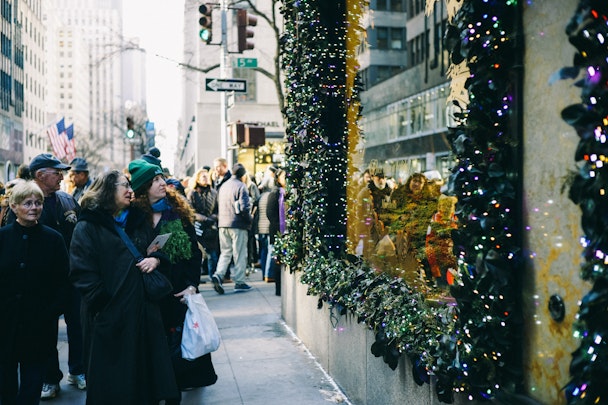Omnichannel: the new norm for Christmas commerce
The retail industry has traditionally evolved at the speed of the seasons, but no more. Now, new trends can be uploaded on social media and shared by millions instantly – this is the new normal. The entire sector, now in hyper-drive, is not for the slow-moving.

Omnichannel: the new norm for Christmas commerce
The power of a brand to drive trends has diminished - trends come and go as quickly as it takes to upload an image. The industry depends on the illusion of change, newness, and must-have trends, but this has reached dizzying new heights.
Technology has been at the forefront of this change, drastically influencing the way people shop and style themselves. Today’s consumers are much more digitally-savvy than their predecessors, craving the convenience of digital content. Retailers, therefore, need to think about how they engage with customers and the channels they use.
Online retailers are flourishing while physical stores continue to struggle, but this doesn’t mean that brick-and-mortar stores are dead. Rather, they just need to evolve to stay relevant as the pace of the market changes.
At Christmas, this is more evident than ever, with brands looking at ways to revitalise their in-store experience.
The revival of in-store
Physical brick-and-mortar stores remain the best way to make a direct and powerful connection between brands and customers. The fact that DNVB brands are investing in stores shows the importance of physical garments in a branded space.
H&M and Inditex have said that they are still in growth mode when it comes to brick-and-mortar. Their net store count is expected to increase this year. Both firms say that online is still less than 15% of overall sales, in contrast to around 27% in the US.
Retail still benefits from meaningful physical engagement. Brick-and-mortar should not be viewed simply as a retail strategy. It is better to think of it as an extension of a brand’s marketing and advertising. And with the festive period just around the corner, retailers are beginning to think about how they can make the most of the Christmas period to bring shoppers in-store
Physical retail isn’t dead, it’s just evolving. Stores remain an essential tool in the multi-channel pantheon of offerings. What’s different now is that they need to complement other channels, and not purely be a sales space – brands must look at connecting the offline and online worlds with energy and consistency.
Christmas displays are here to stay
This is most evident in Christmas window displays. Brands are increasingly understanding the importance of bringing omnichannel to in-stores during the period of increased footfall.
Every experience offer or promotion must be reflected across all other channels. Customers use online, social and mobile as a means of discovery and then frequently purchase the product in-store. The touchpoints need to be coherent, engaging and on-brand to drive maximum value.
Take Argos. We’d expect the items that feature heavily in its 2019 Christmas TV ad – the drum set and ‘Cubby’ the bear – to be front and centre of in-store and online promotions leading up to Christmas. From window displays and in-store banners and prominence in the 2019 catalogue, to being headline products on the Christmas section of the web store and mobile app, this is a joined-up approach that retailers should heed.
Meanwhile, the health and beauty and pharmacy giant, Boots is positioning itself as the answer to modern gifting dilemmas this Christmas. Similar to Argos, its ‘Bootique’ campaign is launched through its feature Christmas TV advertisement, reflected by online and in-store promotions to drive awareness and footfall.
Hamleys in London is another example. As is tradition in the lead-up to Christmas, the company held a celebratory launch event for its much-anticipated window display. The display features a winter wonderland scene and partners with Ty, the Beanie Boos brand, and saw a large social media campaign, featuring cross-promotion with the Matilda London musical to extend reach. Ty products feature prominently on Hamley’s web store and expect lots of social and email campaigns centred around these toys as Christmas approaches.
Additionally, in-store displays can also be used to highlight promotions and extra buying incentives that might be that final hook to convert window-shoppers to buyers. Retailers should make sure the mechanics behind these promotions don’t drastically affect the bottom line, whilst increasing order values. Incentives like free home shipping for larger items, free gift wrapping, or free discount coupons can work well in-store.
Providing a consistent experience
Today’s retail industry is fast-moving, and retailers need to adapt to the new landscape if they are to keep up. The eCommerce boom doesn’t mean that brick-and-mortar stores are no more, it just means that they need to change the way they interact with consumers.
This is particularly important during peak periods like the festive season, on which retailers depend heavily on revenue, meaning the route to purchase needs to be clear and frictionless. This is most powerful when in-store is linked to other channels. Social media or email campaigns can drive traffic to an in-store Christmas event, whilst coupons found in-store can qualify for discounts via the mobile app.
The connection between in-store displays, print, blogs, YouTube channels, product pages, and Instagram posts is crucial, particularly at Christmas when so many retailers are vying for consumer spend. By blending the digital and physical worlds, retailers can provide consumers with the experience they desire and reap the rewards of a coherent festive strategy.
Shane Orchard is head of digital trading and marketing operations at LiveArea.
